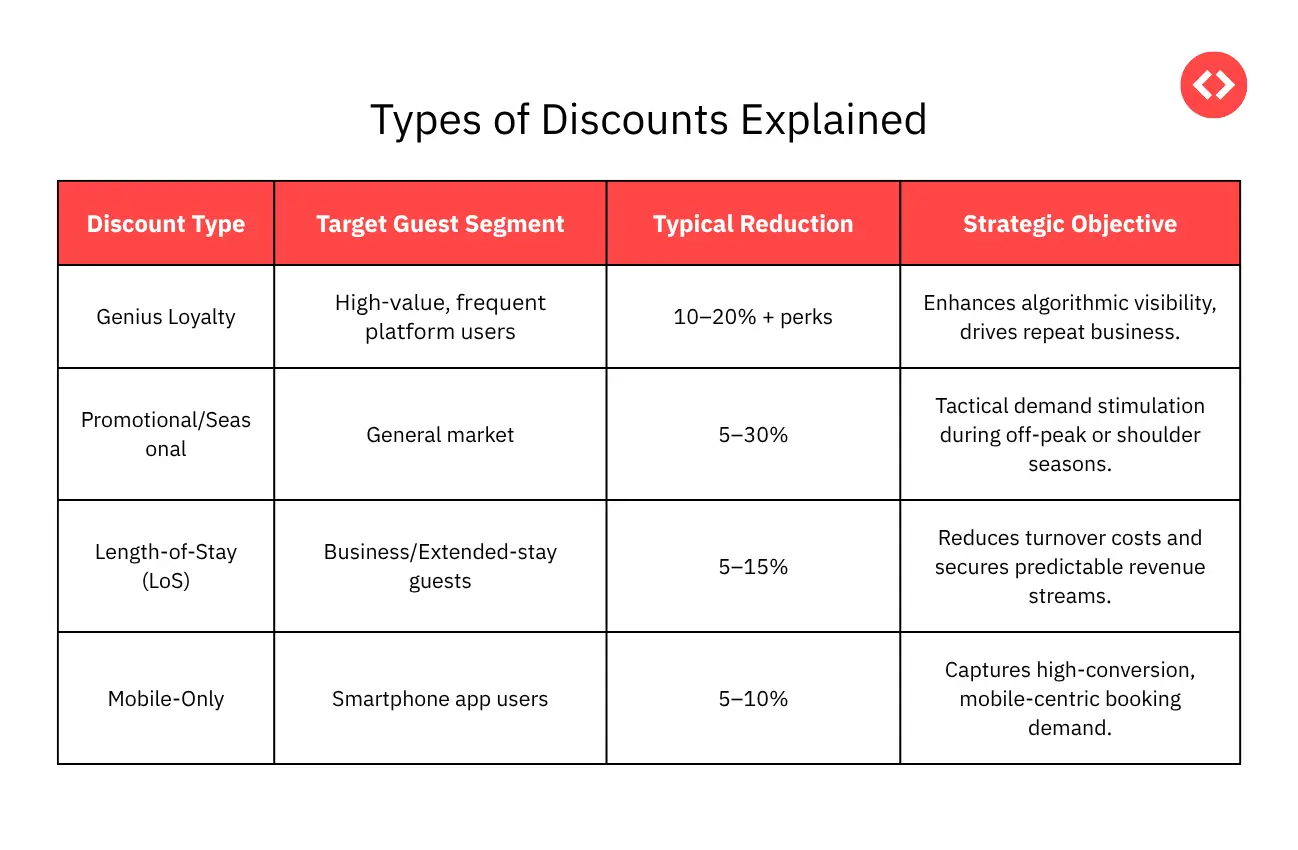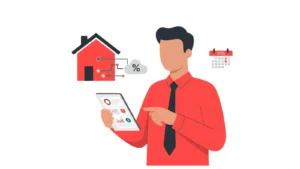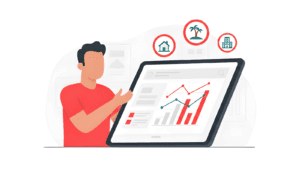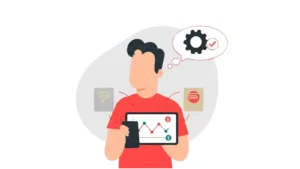Updated : Nov 19, 2025
If you manage a large portfolio—say, 50, 100, or even more vacation rentals—you know that navigating the discount landscape on Booking.com is a complex, high-stakes operational challenge.
Booking.com is massive, commanding over 40% of the global OTA market share. For a professional, large-scale vacation rental property manager, figuring out how to leverage its promotions without destroying your profitability is not just a good idea—it is essential for scalable revenue management.
This guide will show you precisely how modern dynamic pricing for Booking.com software, like PriceLabs, integrates with the platform’s promotional framework. This technological leap enables effortless, automated discount deployment, potentially boosting occupancy while rigorously maintaining the rate integrity and profitability your portfolio demands. We’re here to turn your discount complexity into a significant competitive lever.
Understanding the DNA of Booking.com Discount Logic
Forget manual spreadsheets and ad-hoc coupon codes. Booking.com uses a proprietary Discount Logic algorithm to decide which offers a guest sees.
For your large portfolio, this logic gets incredibly complex, weighing multiple factors in real time:
- Guest Loyalty Status: Are they a Genius member? (Tier 1, 2, or 3?)
- Booking Behavior: Are they booking last-minute, or for an extended stay?
- Your Property’s Performance: How does your listing convert compared to competitors?
The simple truth is, manually managing these complex Booking.com discount rules across 50+ properties is impossible. You need a system that can think fast and act instantly.
This is where a dedicated booking.com pricing software integration like PriceLabs Dynamic Pricing tool for promotions becomes mandatory. PriceLabs integrates directly via API, ensuring real-time synchronization of your rates, inventory, and, most importantly, your complex promotional rules.
The Discounts That Drive Serious Volume
To maximize your revenue on Booking.com, you must strategically deploy the right discount type for the right scenario.

Genius Loyalty Program Discounts
The Genius Loyalty Program is the single most effective tool for boosting property visibility and conversion rates. It rewards frequent users with tiered benefits (Level 1: 10%, Level 3: up to 20% plus premium perks).
Properties participating in Genius consistently report up to 70% higher booking volume due to the program’s dual impact: immediate guest savings plus the algorithmic preference granted in Booking.com’s search rankings. This preferential treatment often yields sufficient incremental volume to justify the cost of the discount.
Promotional Discounts and Seasonal Offers
These discounts offer essential tactical flexibility to address specific inventory or market challenges. They are time-limited and highly customizable (e.g., early bird, last-minute, geo-targeted).
Mobile-only promotions are particularly high-converting, driving 15-20% higher conversion rates among app users. The core strategic value here is stackability. A promotional offer can often be combined with a Genius discount, creating a highly compelling value proposition that finalizes booking decisions.
Package and Bundled Discounts
These offers combine accommodation with high-margin ancillary services or short-term rental upsells (e.g., parking, dining credits, spa access) at a slight collective discount. The operational advantage is clear: you increase total guest spend per visit while enhancing guest satisfaction through a comprehensive experience. This shifts focus from room rate to total booking value.
Length-of-Stay Discounts
These promotions systematically incentivize extended consecutive night stays (e.g., 10% off for 4+ nights). The financial benefits are profound: longer stays significantly reduce turnover costs, decrease housekeeping frequency, and improve the accuracy of your occupancy forecasting by securing future revenue. These incentives are a cornerstone of sophisticated occupancy-based pricing models.

How Pricing Software Handles Booking.com Promotions and Discounts
Modern revenue management systems automate the entire discount lifecycle, transforming it from a resource drain into a core, data-driven strategy component that scales effortlessly.
API Integration with Booking.com for Real-Time Pricing Updates
The Booking.com API provides the technical backbone for instantaneous communication. This direct software link allows for the seamless transmission of rate adjustments, availability status, and promotional rules. When your system’s algorithms detect a spike in booking velocity, the appropriate rates and promotions are updated across all connected properties within minutes, eliminating manual lag time.
”Stop
”You
Automating Dynamic Pricing and Discount Rules
This is the core strategic function. Dynamic pricing automation leverages market intelligence (competitors, events, pace) to deploy discounts based on real-time conditions, rather than fixed calendar rules.
You define precise, rule-based automation triggers: e.g., “Activate a 15% discount for the next week if occupancy forecasting drops below 60%.” Industry data shows that integrated revenue management systems achieve occupancy improvements of up to 40% and ADR increases of 20% by optimizing the timing and depth of discounts based on verifiable market data.

Synchronizing Discounts Across Multiple Channels
This critical function is managed by the Channel Manager, the central hub for distribution. It ensures that any pricing decision (including discounts) made by your booking.com pricing software is applied consistently and accurately across Booking.com, your direct site, and all other OTAs. This prevents rate parity violations and guest confusion. (https://Booking.com/Other) OTAs/PMS]

Strategies for Implementing Effective Booking.com Discounts at Scale
Successful discount implementation demands a systematic approach focused on maximizing RevPAR (Revenue Per Available Room) across the entire portfolio.
Analyzing Market and Competitor Pricing Dynamics
Strategic discount deployment must be founded on real-time competitive intelligence or market based pricing. Automated tools continuously monitor rival rates, promotions, and inventory. For example, if seasonal data predicts a 30% drop in corporate demand, proactive seasonal leisure promotions are activated to maintain optimal occupancy-based adjustments.
Leveraging the Genius Program for Increased Visibility
Prioritize Genius participation for properties where the visibility boost provides the greatest competitive lift, such as new assets or high-competition urban markets. The goal is to ensure Genius discounts attract incremental demand—new guest segments—rather than simply cannibalizing existing full-rate bookings. Track the ratio of Genius bookings vs. standard rates to measure the program’s true ROI.
Designing Tailored Promotions Aligned with Guest Behavior
Use behavioral data (booking window, device usage) to target specific segments: Mobile-only deals for high-conversion smartphone users; Early Bird offers for advance planners; Flash Sales to rapidly clear last-minute inventory. Effective execution requires seamless coordination with inventory management to ensure promotional availability is accurate.
Utilizing Channel Managers for Price and Availability Consistency
Channel manager integration ensures that the sophisticated pricing decisions from your revenue software translate into real-time, accurate distribution. This continuous synchronization is the primary safeguard against operational failure (e.g., overbooking, rate discrepancies) inherent in high-volume, multi-channel operations.
Measuring Success: Key Metrics to Track Discount Impact
Practical discount strategy evaluation requires comprehensive performance measurement that extends beyond simple booking volume to encompass profitability, guest satisfaction, and competitive positioning. Large property managers must establish consistent measurement frameworks that enable portfolio-wide optimization while identifying variations in individual property performance.
Successful measurement combines leading indicators that predict future performance with lagging indicators that confirm the effectiveness of the strategy. This dual approach enables proactive strategy adjustments while providing definitive ROI calculations for promotional investments.
Revenue Per Available Room (RevPAR)
Revenue Per Available Room is the primary metric for evaluating the effectiveness of the discount strategy because it captures both occupancy improvements and rate optimization in a single metric. RevPAR equals total room revenue divided by the total number of available rooms, providing a comprehensive view of how well properties fill rooms at profitable rates.
Effective RevPAR analysis compares performance before and after the implementation of discounts, while accounting for market conditions and seasonal variations. A successful promotional campaign should increase RevPAR even when offering discounts, indicating that volume improvements more than offset rate reductions.
Monthly RevPAR tracking enables the identification of seasonal patterns and promotional effectiveness across different time periods.
Average Daily Rate (ADR)
Average Daily Rate measures the average room revenue earned per occupied room, calculated as total room revenue divided by the number of rooms sold. While discounts typically reduce ADR, strategic implementation can maintain or even increase ADR through improved guest mix and upsell revenue.
ADR analysis should segment promotional bookings from standard-rate reservations to better understand the true impact of discount strategies. If promotional rates attract guests who spend significantly more on ancillary services, total revenue per guest might exceed that of standard-rate customers despite lower room rates.
Competitive ADR benchmarking provides context for promotional pricing decisions. If market ADR averages $150 and promotional rates achieve $135 while generating 40% higher occupancy, the strategy delivers superior RevPAR performance despite the rate reduction.
Occupancy Rate and Booking Conversion
Occupancy rate represents the percentage of available rooms filled during a specific period, while booking conversion measures the ratio of booking inquiries that result in confirmed reservations. Both metrics provide insight into promotional effectiveness and guest response to discount offers.
Occupancy analysis should distinguish between promotional and standard rate bookings to evaluate whether discounts generate incremental demand or simply reduce revenue from existing booking intent. Successful promotional strategies increase total occupancy while maintaining reasonable average rates.
Booking conversion tracking reveals promotional appeal and competitive positioning. If promotional offers generate high inquiry volume but low conversion rates, pricing might be uncompetitive, or booking conditions might be too restrictive. Conversely, high conversion rates with low inquiry volume indicate insufficient promotional visibility or targeting.
Frequently Asked Questions (FAQs) for Professional Property Managers
1. How does PMS integration specifically help with managing discounts?
PMS integration ensures that your core operational system (PMS) is instantly aware of rate changes and promotional bookings. This prevents the catastrophic issue of overbooking during high-volume discount campaigns by enabling real-time inventory synchronization across all channels. It is the technical bridge that connects pricing strategy with operations.
2. Is there a risk of discount stacking severely eroding my profit margins?
Yes, if not managed correctly. Booking.com pricing software is critical here because it maintains a discount hierarchy. When multiple discounts apply, the software evaluates all combinations and applies the resulting rate while protecting your pre-set minimum rates, preventing decrease in your ADR.
3. How do I implement effective blackout dates for promotions across 50+ properties?
Automated systems allow you to set portfolio-wide or property-specific blackout dates (periods when a promotion is invalid) based on your occupancy forecasting and known high-demand periods. This ensures that you maximize revenue by not discounting inventory that you can sell at a premium.
4. Why is RevPAR considered a better measure of success than just Occupancy?
Occupancy alone can be misleading; you could be 100% full but losing money. RevPAR is the ultimate profitability metric because it factors in both occupancy and the rate you achieved. A successful discount strategy is one that yields a higher RevPAR, proving that the increased volume was worth the rate concession.
5. What is the main compliance risk when using heavy discounts on Booking.com?
The main risk is rate parity violations. Booking.com generally requires you to offer consistent pricing. While Genius and Mobile-Only are permissible exceptions, offering significantly lower rates on competing platforms can result in penalties or reduced visibility. Your channel manager and pricing software must enforce parity consistency across all distribution channels.argeted precision is why integrated revenue management systems achieve occupancy improvements of up to 40% alongside rate increases.






